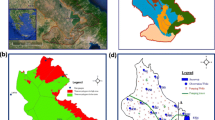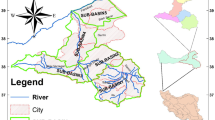Abstract
This paper presents the results of studies on water resources management strategies, under the influence of climate change, in the Zarrineh River basin, providing some 41% of the total inflow into the Lake Urmia. Climate change simulation over the period 1992–2050 was performed by downscaling of seven global circulation models. The best model was then selected for modelling the hydrological behavior of the basin using a rainfall-runoff model while an allocation model was used to evaluate future supply and demands. A system dynamics model was further utilized to investigate the sustainability of the dynamic behavior of the basin. Five suggested water resources management strategies for two future climate scenarios were investigated. Results indicated that implementation of the strategy of 40% reduction in agricultural water demand would provide higher degrees of sustainability. Based on this, the average annual inflow to Lake Urmia in the years 2021 to 2050 would be 1029.75 MCM, which is equal to 81.02% of the Lake Urmia’s environmental requirement from the river’s share.







Similar content being viewed by others
References
Abadi LSK, Shamsai A, Goharnejad H (2015) An analysis of the sustainability of basin water resources using Vensim model. KSCE J Civ Eng 19:1941–1949. https://doi.org/10.1007/s12205-014-0570-7
Abbaspour M, Nazaridoust A (2007) Determination of environmental water requirements of Lake Urmia, Iran: an ecological approach. Int. J. Environ. Stud. 64:161–169
Adger N, Brown K, Nelson D, Berkes F, Eakin H, Folke C, Galvin K, Gunderson L, Goulden M, O'Brien K, Jack Ruitenbeek J, Tompkins E (2011) Resilience implications of policy responses to climate change. WIREs CLIMATE CHANGE 2(5):757–766. https://doi.org/10.1002/wcc.133
Ahmadaali J, Barani G, Qaderi K, Hessari B (2018) Analysis of the effects of water management strategies and climate change on the environmental and agricultural sustainability of Urmia Lake basin, Iran. Journal of Water 10(2):1–21. https://doi.org/10.3390/w10020160
Ahmadi A, Abbaspour M, Arjmandi R, Abedi Z (2016) Resilient approach toward urban development in Lake catchments; case of Lake Urmia. Scientia Iranica 23(4):1627–1632
Ahmadzadeh Kokya T, Pejman A, Mahin Abdollahzadeh E, Ahmadzadeh Kokya B, Nazariha M (2011) Evaluation of salt effects on some thermodynamic properties of Urmia Lake water. Int J EnvironRes 5343–8
Alborzi A, Mirchi A, Moftakhari H, Mallakpour I, Alian S, Nazemi A, Hassanzadeh E, Mazdiyasni O, Ashraf S, Madani K, Norouzi H, Azarderakhsh M, Mehran A, Sadegh M, Castelletti A, AghaKouchak A (2018) Climate-informed environmental inflows to revive a drying lake facing meteorological and anthropogenic droughts. Environ Res Lett 13(2018):084010. https://doi.org/10.1088/1748-9326/aad246
Arnell N (1999) Climate change and global water resources. Glob Environ Chang 9(1):S31–S49. https://doi.org/10.1016/S0959-3780(99)00017-5
Blanco-Gutiérrez I (2010) Economic-hydrologic analysis of water management strategies for balancing water for nature and water for food: implications for the Guadiana River basin. Spain. Doctoral Thesis. Polytechnical University of Madrid
Boroughani M, Hashemi H, Hosseini SH, Pourhashemi S, Berndtsson R (2019) Desiccating Lake Urmia: a new dust source of regional importance. IEEE Geosci Remote Sens Lett 17:1483–1487. https://doi.org/10.1109/LGRS.2019.2949132
Delju A, Ceylan A, Piguet E, Rebetez M (2013) Observed climate variability and change in Urmia Lake Basin, Iran. Theor Appl Climatol 111:285–296
Dibike YB, Coulibaly P (2005) Hydrologic impact of climate change in the Saguenay watershed: comparison of downscaling methods and hydrologic models. Journal of Hydrology, 9 June 307(1–4):145–163
Eberlein RL, Peterson DW (1992) Understanding models with Vensim. Eur J Oper Res 59(1):216–219. https://doi.org/10.1016/0377-2217(92)90018-5
Emami F, Koch M (2018) Agricultural water productivity-based hydro-economic modeling for optimal crop pattern and water resources planning in the Zarrineh River basin, Iran, in the wake of climate change. Sustainability. 10:3953. https://doi.org/10.3390/su10113953
Fang GH, Yang J, Chen YN, Zammit C (2015) Comparing bias correction methods in downscaling meteorological variable for a hydrologic impact study in an arid area in China. Hydrol Earth Syst Sci 19:2547–2559. https://doi.org/10.5194/hess-19-2547-2015
Fowler HJ, Ekström M, Blenkinsop S, Smith AP (2007) Estimating change in extreme European precipitation using a multimodel ensemble. J Geophys Res 112:D18104. https://doi.org/10.1029/2007JD008619
Ford A (1999) Modeling the environment: an introduction to system dynamics modeling of environmental systems. Island Press, Washington DC
Forrester JW (1961) Industrial dynamics. MIT Press, Cambridge
Forrester JW (1969) Urban dynamics. MIT Press, Cambridge
Gandure S, Walker S, Botha JJ (2013) Farmers' perceptions of adaptation to climate change and water stress in a south African rural community. Environmental Development 5:39–53. https://doi.org/10.1016/j.envdev.2012.11.004
García-Cascales MS, Lamata MT (2012) On rank reversal and TOPSIS method. Math Comput Model 56:123–132. https://doi.org/10.1016/j.mcm.2011.12.022
Ghale YAG, Altunkaynak A, Unal A (2018) Investigation an anthropogenic impacts and climate factors on drying up of Urmia Lake using water budget and drought analysis. Water Resour. Manage. 32:325–337
Ghaheri M, Baghal-Vayjooee M, Naziri J (1999) Lake Urmia, Iran: a summary review. Int. J. Salt Lake Res. 8:19–22
Gohari A, Mirchi A, Madani K (2017) System dynamics evaluation of climate change adaptation strategies for water resources Management in Central Iran. Water Resour Manag 31:1413–1434. https://doi.org/10.1007/s11269-017-1575-z
Gholampour A, Nabizadeh R, Hassanvand MS, Taghipour H, Nazmara S, Mahvi AH (2015) Characterization of saline dust emission resulted from Urmia Lake drying. J. Environ. HealthSci. Eng. 13 82
Hashimoto T, Stedinger JR, Loucks DP (1982) Reliability, resiliency and vulnerability criteria for water resource system performance evaluation. Water Resour Res 18(1):14–20. https://doi.org/10.1029/WR018i001p00014
Hassanzadeh E, Zarghami M, Hassanzadeh Y (2012) Determining the main factors in declining the Lake Urmia level by using system dynamics modeling. Water Resour Manage. 26:129–124
Hwang C L, Yoon K (1981) Multiple attribute decision making: methods and applications: a state of the art survey, springer-Verlag, Berlin; Heidelberg; New York
IPCC (2013) Climate change 2013: the physical science basis, contribution of working group I to the fifth assessment report of the intergovernmental panel on climate change. Cambridge University press, Cambridge, UK; New York, USA
Jalili S, Hamidi SA, Namdar Ghanbari R (2016) Climate variability and anthropogenic effects on Lake Urmia water level fluctuations, northwestern Iran. Hydrol Sci J 61(10):1759–1769
Joyce BA, Mehta VK, Purkey DR, Dale LL, Hanemann M (2011) Modifying agricultural water management to adapt to climate change in California’s central valley. Clim Chang 109(1):299–316
Juwana I, Muttil N, Perera BJ (2012) Indicator-based water sustainability assessment - a review. Sci Total Environ 1(438):357–371. https://doi.org/10.1016/j.scitotenv.2012.08.093
Klemes V, Srikanthan R, McMahon TA (1981) Long-memory flow models in reservoir analysis: what is their practical value? Water Resour Res 17(3):737–751. https://doi.org/10.1029/WR017i003p00737
Langsdale S, Beall A, Carmichael J, Cohen S, Forster C (2007) An exploration of water resources futures under climate change using system dynamics modeling. Integr Asses J 7(1):51–79
Li F, Zhang G, Xu YJ (2014) Separating the impacts of climate variation and human activities on runoff in the Songhua River Basin, Northeast China. Water. 6(11):3320–3238
Loucks DP (1997) Quantifying trends in system sustainability. Hydrolog Sci J 42(4):513–530. https://doi.org/10.1080/02626669709492051
MacDonald GM (2010) Water, climate change, and sustainability in the southwest. PNAS 107(50):21256–21262. https://doi.org/10.1073/pnas.0909651107
McMahon TA, Adeloye AJ, Zhou SL (2006) Understanding performance measures of reservoirs. J Hydrol 324(1):359–382
McSweeney CF, Jones RG, Lee RW, Rowell DP (2015) Selecting CMIP5 GCMs for downscaling over multiple regions. Clim Dyn 44(Issue 11–12):3237–3232
Mirchi A, Madani K, Watkins D, Ahmad S (2012) Synthesis of system dynamics tools for holistic conceptualization of water resources problems. Water Resour Manag 26(9):2421–2442. https://doi.org/10.1007/s11269-012-0024-2
Mizanur Rahaman M, Varis O (2005) Integrated water resources management: evolution, prospects and future challenges, sustainability: science. Practice and Policy 1(1):15–21. https://doi.org/10.1080/15487733.2005.11907961
Mugatsia EA (2010) Simulation and scenario analysis of water resources management in Perkerra catchment using WEAP model. Master Thesis, Department of Civil and Structural Engineering, School of Engineering, Moi University, Kenya
Nikbakht J, Tabari H, Talaee PH (2013) Streamflow drought severity analysis by percent of normal index PNIin Northwest Iran. Theor. Appl. Climatol 112:565–573
Nkomozepi T, Chung SO (2014) The effects of climate change on the water resources of the Geumho River basin, Republic of Korea. Journal of Hydroenvironment Research, December 8(4):358–366
Prodanovic P, Simonovic SP (2010) An operational model for support of integrated watershed management. Water Resour Manag 24(6):1161–1194. https://doi.org/10.1007/s11269-009-9490-6
Richter BD, Brown JD, DiBenedetto R, Gorsky A, Keenan E, Madray C, Morris M, Rowell D, Ryu S (2017) Opportunities for saving and reallocating agricultural water to alleviate water scarcity. Water Policy 19(5):886–907
Sandoval-Solis S, McKinney DC, Loucks DP (2011) Sustainability index for water resources planning and management. J Water Resour Plan Manage 137(5):381–390. https://doi.org/10.1061/(ASCE)WR.19435452.0000134
Santikayasa IP, Babel MS, Shrestha S, Jourdain D, Clemente RS (2014) Evaluation of water use sustainability under future climate and irrigation management scenarios in Citarum River basin, Indonesia. International Journal of Sustainable Development & World Ecology 21(2):181–194
Seibert J (2003) Reliability of model predictions outside calibration conditions. Nord Hydrol 34(5):477–492. https://doi.org/10.2166/nh.2003.028
Shadkam S, Ludwig F, van Oel P, Kirmit Ç, Kabat P (2016) Impacts of climate change and water resources development on the declining inflow into Iran’s Urmia Lake. Great Lakes Res 42:942–952
Siegfried T, Bernauer T, Guiennet R, Sellars S, Robertson AW, Mankin J, Bauer-Gottwein P, Yakovlev A (2011) Will climate change exacerbate water stress in Central Asia? Clim Chang 112:881–899. https://doi.org/10.1007/s10584-011-0253-z
Simonovic SP, Li L (2003) Methodology for assessment of climate change impacts on large-scale flood protection system. J Water Resour Plan Manage 129(5):361–371. https://doi.org/10.1061/(ASCE)0733-9496(2003)129:5(361)
Simonovic SP, Li L (2004) Sensitivity of the Red River basin flood protection system to climate variability and change. Water Resour Manag 18(2):89–110
Singh VP, Prakash Khedun C, Mishra AK (2014) Water, environment, energy, and population growth: implications for water sustainability under climate change. J Hydrol Eng 19(4):667–673
Srdjevic Z, Srdjevic B (2017) An extension of the sustainability index definition in water resources planning and management. Water Resour Manag 2017(31):1695–1712
Sterman JD (2000) Business dynamics, systems thinking and modeling for a complex world. McGraw-Hill, Boston
Teutschbein C, Seibert J (2012) Bias correction of regional climate model simulations for hydrological climate-change impact studies: review and evaluation of different methods. J Hydrol 456-457:12–29. https://doi.org/10.1016/j.jhydrol.2012.05.052
Torabi Haghighi A, Klove B (2017) Design of environmental flow regimes to maintain lakes and wetlands in regions with high seasonal irrigation demand. Ecol Eng 100:120–129
Urmia Lake Restoration National Committee (2015) Necessity of Lake Urmia Resuscitation, Causes of Drought and Threats; Report No: ULRP-6-43-Rep 1. [in Persian]
Ventana Systems (2010) User’s guide version 5, Ventana Systems, Inc. Retrieved from http://www.vensim.com
Winz I, Brierley G, Trowsdale S (2009) The use of system dynamics simulation in water resources management. Water Resour Manag 23(7):1301–1323. https://doi.org/10.1007/s11269-008-9328-7
Xiao-jun W, Jian-yun Z, Jian-hua W, Rui-min H, ElMahdi A, Jin-hua L, Xin-gong W, Shahid S (2014) Climate change and water resources management in Tuwei river basin of Northwest China. Mitigation Adapt Strateg Glob Chang 19(1):107–120. https://doi.org/10.1007/s11027-012-9430-2
Yates D, Purkey D, Sieber J, Huber-Lee A, Galbraith H (2005a) WEAP21—a demand-, priority-, and preference-driven water planning model: part 2: aiding freshwater ecosystem service evaluation. Water Int 30(4):501512
Yates D, Sieber J, Purkey D, Huber-Lee A (2005b) WEAP21-a demand-, priority-, and preference-driven water planning model: part 1: model characteristics. Water Int 30(4):487–500
Yazdandoost F, Moradian S (2019) Climate change impacts on the streamflow of Zarrineh River. Iran Journal of Arid Land. https://doi.org/10.1007/s40333-020-0124-4
Yilmaz B, Harmancioglu NB (2010) An indicator-based assessment for water resources management in Gediz river basin, Turkey. Water Resour Manag 24(15):4359–4379
Zarghami M, AmirRahmani M (2017) A system dynamics approach to simulate the restoration plans for Urmia Lake, Iran. Optimization and dynamics with their applications. A Matsumoto (Singapore: springer) pp 309–26
Zhai R, Tao F (2017) Contributions of climate change and human activities to runoff change in seven typical catchments across China. Sci Total Environ 605:219–212
Author information
Authors and Affiliations
Corresponding author
Ethics declarations
Conflicts of Interest
The authors declare that they have no conflict of interest.
Additional information
Publisher’s Note
Springer Nature remains neutral with regard to jurisdictional claims in published maps and institutional affiliations.
Rights and permissions
About this article
Cite this article
Yazdandoost, F., Moradian, S. & Izadi, A. Evaluation of Water Sustainability under a Changing Climate in Zarrineh River Basin, Iran. Water Resour Manage 34, 4831–4846 (2020). https://doi.org/10.1007/s11269-020-02693-3
Received:
Accepted:
Published:
Issue Date:
DOI: https://doi.org/10.1007/s11269-020-02693-3




